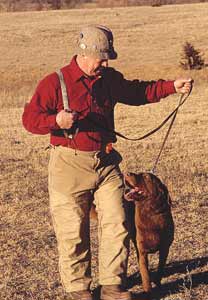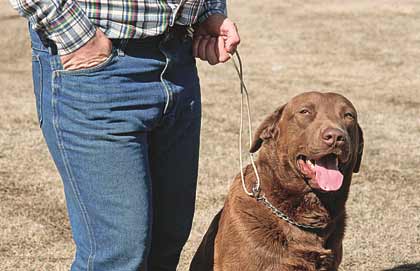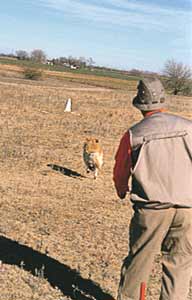A refresher course on the basics will get your Gun dog ready for the season.
By James B. Spencer
 You can sharpen up your dog's heeling with mild corrections, like a few tugs on the lead. |
If you've been training your retriever regularly, averaging twice a week or more all spring and summer, he shouldn't need a special pre-hunting tune-up. Just keep doing what you've been doing. However, if you've allowed Mallard-Muncher to lie around most of the time while you coached little league baseball or hauled in huge fish, he's ripe for a pre-season tune-up. You need to get him in shape, and refresh his memory relative to the duties of his noble calling.
For information on getting him into proper condition, read "Pro Tips" in this issue, which covers that subject thoroughly. But for some thoughts on how to remind him of his responsibilities as a hunting dog, continue reading here.
What Not To Do
If you've waited this long, you don't have much time for a tune-up. Even so, you shouldn't panic and rush into whatever level of advanced training M-M has previously attained. No tricky multiple marks. No "into the valley of death" blind retrieves. You're not cramming for an exam. You're simply trying to re-awaken M-M's most basic hunting skills.
If you give him challenging tests, he will fail quite often, so you'll correct him quite often. He'll get down on both himself and you. You'll get angry at both him and yourself. When you finally do get to go hunting, instead of working together as a team, you'll be at cross-purposes too much of the time.
Your Attitude
First, you need to adjust your own attitude and expectations. You can't blame M-M for his lack of recent training. No matter how valid your reasons for not training regularly were, you are the fall guy here. Therefore, you shouldn't start out dreaming about the wonder dog you would like him to be on opening day, or even the semi-wonder dog he may have been in the past.
Starting the training process this late, neither of the above is a feasible goal. If you attempt to cram in that level of training into such a short time, you'll do more harm than good. If you'd like him to be at that level next year, plan now to start training him early next spring.
Right now, consider only where he is today, and then estimate where you can reasonably expect to take him by opening day. Dogs lose their training rather rapidly when not worked regularly. An old office joke goes as follows: "The boss doesn't allow graduates of such-and-such a college to take coffee breaks because it takes too long to re-train them!" Retrievers are somewhat like that, too.
In this pre-season tune-up, you want not only to refresh M-M's training as much as possible, but perhaps more importantly you want to build his self-confidence and re-establish his rapport with you. You can't accomplish these latter two with predominantly negative training. You can't correct a dog into believing in himself. Nor can you correct him into bonding with you.
Ergo, this tune-up must be mostly positive. M-M should succeed most of the time. And you should praise him when he does.
Basic Obedience
In every training session, you should include a few minutes working on the basic obedience commands: Heel, Come, Sit, Stay, Kennel, and Down. Through these you establish, maintain and re-establish (as necessary) basic control. The dog that gets sloppy in his responses to those obedience commands will get sloppy in other areas of training.
 In your early refresher marks, focus on steadiness, even going back to the belt cord if necessary to keep him from breaking. |
He'll start creeping, even breaking. He'll start slipping whistles and refusing casts. He'll start switching and sucking back to old falls. Canine logic goes something like this: "If the boss' obedience commands are little more than tentative requests, why should I take his other, more advanced commands seriously?"
And yet so many people "hate to waste training time on basic obedience" after initially training their pups on these commands. But five to 10 minutes isn't much time out of a two- or three-hour training session, and spending that five or 10 minutes on a basic obedience refresher is not wasting time.
Actually, you can do most of it at home on your own, rather than while out working dogs with your training group. Just put in a few minutes early in the morning before work, a few more minutes late in the evening, just before bedtime.
You can easily keep your obedience refresher positive. Your dog knows the routine and any needed corrections can be quite gentle, like a jerk on the lead or checkcord. Thus, in each session you'll have abundant opportunities to praise your dog for good work. If you take advantage of these opportunities, both control and rapport will re-blossom.
Marking
Your retriever can get by as a hunting dog if he can do only single marks and blind retrieves. Granted, that's a minimum. It'll save you a lot of whistle-tooting and arm-waving if he also does multiple marks. However, with so little time to tune him up, you should concentrate on the minimum and then add refinements as time allows.
Give your under-worked and rusty M-M mostly single marks, especially at first. This will not only sharpen up his "marking eye," but will also build his self-confidence, as well as give you plenty of opportunities to praise him, thereby building rapport.
If you train with a more advanced group that does mostly multiple marks, let M-M do each mark as a single. Focus especially on keeping him steady. Don't let him break or even creep. You might go back to the belt-cord at first, so you can keep him steady without severe corrections.
After a few sessions, if he's doing quite well on single marks, you should add simple doubles, but only with preceding "rehearsals." First, run him on two singles and then on the pair as a double.
After several successful sessions this way, you might add an occasional very simple triple, with adequate "rehearsals." Run each of the two memory birds as a single, then those two as a double, and finally all three marks as a triple.
But keep everything very basic. You don't have time to challenge him with marks so long and haz
ard-filled that they might confuse him and undo the good you've accomplished.
Blind Retrieves
To keep everything simple in blind retrieves, you should give M-M mostly drills in the three parts of a blind retrieve, namely, lining, stopping, and casting. My book, Retriever Training Drills for Blind Retrieves, explains several drills for each of these three.
Lining drills encourage long, straight lines. Stopping drills encourage consistently rapid responses to the Sit-whistle. Casting drills encourage long, straight casts. Only when your dog is proficient in each of these three parts can he do a real blind retrieve properly.
 In this visual aid lining drill, the dog has been launched and is about halfway to the dummy pile. |
Here's a simple and very effective combination stopping and casting drill (see book, pages 71-72). Take your dog for a romp in the field. When he is distracted and running away from you, toot the Sit-whistle. If he doesn't sit, or if he's slow to sit, correct him with whatever method you have used in the past. After he's sitting, whether voluntarily or after a correction, toss a dummy off to either side and cast him to it.
After a few of these, he will expect a retrieve after he sits, so he will plunk it down with all deliberate promptitude. What's more, he'll sit facing you, looking intently at you, pleading with you to toss the dummy. This level of attentiveness facilitates handling in real blind retrieves.
In each romp, you should repeat this stopping and casting drill several times. Eventually, you can toss the dummy in various directions to work him on different casts. Make it land between him and you for the Come-in cast. Fling it over his head and behind him for the Back cast. Toss it off to either side for Over casts. And drop it in appropriate places to either side for angled Back and Come-in casts.
This is a very effective stopping and casting drill, one your dog will love, and one he will do correctly every time, which is just what you need in your pre-season tune-up. He will enjoy it so much that he will sometimes stop without hearing the Sit-whistle. When he anticipates this way, simply ignore him and don't toss the dummy. You, not M-M, should be in control here.
If you have time before hunting season, you might give him an occasional real but very simple blind retrieve.
Verba Sapientibus (Words for the Wise)
Throughout your tune-up marks and blinds, remember that what M-M needs most are confidence-builders, not character-builders!
Nota Bene
Jim Spencer's books can be ordered from the Gun Dog Bookshelf: Training Retrievers for Marshes & Meadows; Retriever Training Tests; Retriever Training Drills for Marking; Retriever Training Drills for Blind Retrieves; HUP! Training Flushing Spaniels the American Way; and POINT! Training the All-Seasons Bird Dog.






